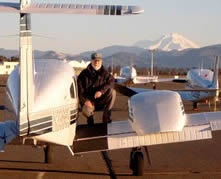| Flight Training NAVIGATION |
|---|
| About Us |
| Sailplanes |
| Seaplanes |
| Aerobatics |
| Songs |
| Articles |
| Links |
PandA Training Design, Evaluation |
 |
|---|
Seven Golden Rules of Instruction
FOUR - SEEK AND GIVE FEEDBACK
Did the student understand what I said? How can I find out what he perceived? and Does the student know what I thought of the attempt. These are the three central questions which help structure feedback. When talking before a large group we often look for signs that at least some people understand. If it is important that everyone understand, then we must give a quiz. When talking to one student we can form questions that will tell us whether the correct concept was received.
One major roadblock to learning is the illusion on the part of the instructor that it has occurred. "I told him and told him, and he still did it wrong." Simple feedback techniques, such as "OK?" and waiting for a nod can promote this illusion. Think about it. It is expected that you will nod your head when someone says "OK." It is expedient to nod, rather than incur a disgusted glance, a deep breath and another explanation. Often the student will nod in good faith, not realizing that only a portion of the concept was understood.
When teaching to behavioral objectives it is imperative that you measure the result. Did the student meet the objective? This requires feedback to be structured and organized to show when the student is ready to move to the next objective.
FOLLOWING A WRONG CONCEPT
I have learned to recognize an important clue indicating that a student is following a wrong concept. If I ask for something simple and straight-forward and the student looks quizzical, there may be either a miscommunication, or the student has the wrong basic concept. My request doesn't make sense within his frame of reference. For instance, when I asked a student to climb to 3000 feet, he looked quizzical, hesitated, then asked "How high is it where we need oxygen?" He showed good judgment in checking, but his ground school lesson had been incompletely learned.
A wrong concept may be indicated if the aircraft is doing funny things. Many students have trouble on final because they don't use the rudder correctly. To see how this looks, make an approach with your feet off the rudder pedals. One student kept increasing the left rudder trim on a cross country flight even though the right wing continued o get lower and lower. I asked him why he was trimming the ball so far out to the right? He said he was just cranking in the cross-wind correction. "If you put in just enough trim" he said, "you will go right down the course line.
One student came completely unglued when I demonstrated a stall. He was an engineering student who had observed destructive testing of metals. He said "I've seen how a bolt hole will elongate just a little bit - then it fails catastrophically, and I know how old this airplane is." After I explained my own confidence in the inspection procedures, and how they are designed to catch early indications of impending failures, he was able to do stalls without ceasing to breathe. It took quite a lot of experience before he was totally comfortable, however.
POSITIVE FEEDBACK
If we fail to praise good performance, we miss out on one of the most powerful teaching tools available. When using behavioral objectives there is a tendency to give only corrective feedback until the objective has been met, then go on to the next objective. Instructors often look only for the final criterion, and take it as an expected occurrence. The student, on the other hand, has been wondering if he will ever master this task. Intermediate criteria must be used which can be achieved on each flight. We must praise everything that the student does better than at the beginning of the lesson.
I had been worried about John. Although he was using his VA benefits to pay for his commercial pilot course, he seemed timid, cautious, and quite nervous during every flight lesson. His progress was very slow, and he did not have a desire to use his piloting skill after he finished the course. One day he performed a Lazy Eight exactly the way I believe it should be done. I said "John, that was the best Lazy Eight I have ever seen! That's the way I would like to do it on my best day! I reached across the cockpit and sincerely shook his hand. Then I said "Do another." He did! I rejoiced out loud. I followed it up when we walked into the operations office. The pilot examiner and two other instructors with their students were standing around as John completed the paper work. I said to the pilot examiner "Len, you should have seen the Lazy Eight that John just did. When you give him his check ride he will show you how I believe they should be done." The effect on John was unbelievable. When he showed up for his next lesson, he was an eager learning machine. After passing his check ride with flying colors, he bought his own airplane for "family travel and personal fun."
Summary